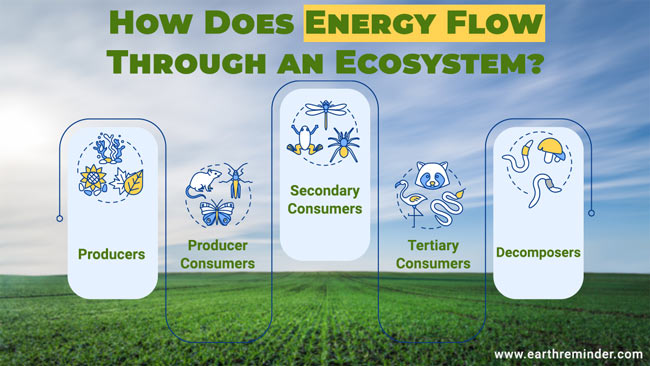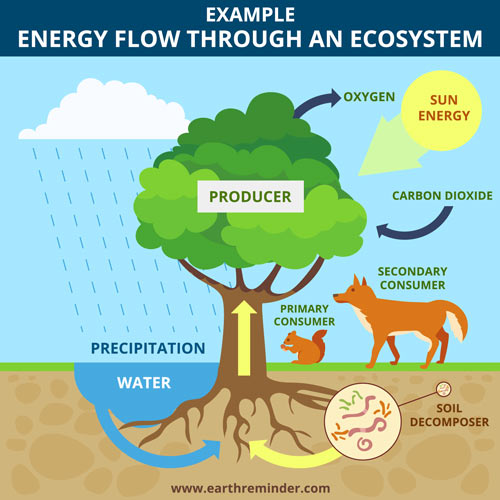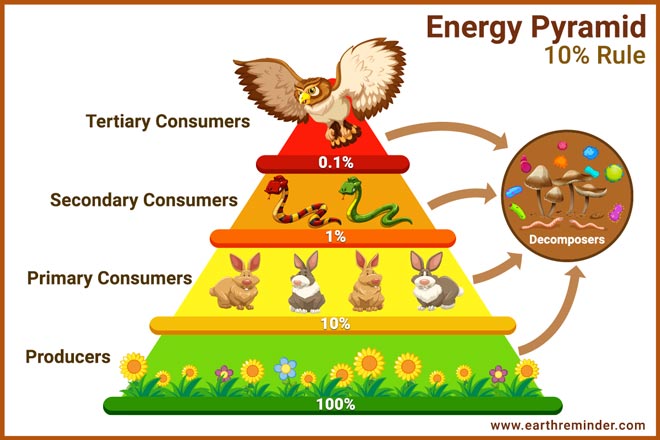How Does Energy Flow Through an Ecosystem?
Our planet remains habitable because there is a continuous reinforcement and reintroduction of resources in it. So plants, soil, water, air are constantly recharged at a certain rate to keep the energy flowing in our ecosystem. Therefore, it is important to understand how does energy flow through an ecosystem.
Just imagine, what if all the plants on Earth disappeared along with all the algae and bacteria? There would be no photosynthesis and we will have no food to eat. This planet of ours, which looks beautiful now will look sad and barren instead. We would also not have oxygen anymore and therefore, no metabolism.
Earth will start warming up fast as there will be nothing to absorb the carbon dioxide and as an ultimate result- all living things will die. By now, it must have become clear that the photosynthesizers are the ones that make the energy flow possible. It is also clear that only when energy flows in an ecosystem, we have an Earth worth living.
Table of Contents
How Does Energy Move Through an Ecosystem?
Now, the question is how does energy move through an ecosystem? How does it get passed? The answer to this lies in understanding the concept of trophic levels first. So, any ecosystem has many trophic levels.
Trophic here means the level of energy or the amount of energy present amongst the organisms coming under that level.
- The first trophic level consists of producers. Plants constitute these producers. They are the ones that have the primary responsibility of transferring energy to others. Producers i.e. plants can synthesize nutrients. They get it from the sun and turn it into nutrients that can be absorbed by other species. This is how the energy flow begins in an ecosystem.
- The second is the consumers. These are the herbivores that are at the second trophic level. They make use of plants and make them their food which in turn gives them energy. The functions of metabolism of these animals for example breathing and digesting food happens due to the use of this energy. This energy also supports the growth of tissues, maintains blood circulation along with the body temperature of animals.
- The third trophic level is of carnivores. They eat the herbivores and get their energy for growth and survival on this planet. Within carnivores also, there are larger animals that eat other animals. These represent a higher trophic level within the third level.
- Therefore, we can see that different plants and animals are dependent on each other for food and this forms the basic energy flow in an ecosystem. This is how energy moves in an ecosystem.
- There are some other organisms too which are called decomposers. These consist of organisms like bacteria, fungi, molds, worms, and insects amongst many others. These decomposers break down the wastes produced by other animals and the organic dead matter left by them.
- This breaking down of waste produced by other organisms eventually benefits the quality of soil and helps in starting the process of energy flow all over again. The producers get their food from the nutrients broken down by these decomposers. Therefore, energy is released.
The Flow of Energy Within Trophic Levels of An Ecosystem:
The flow of energy in an ecosystem is only in one direction. So, it moves from primary producers to primary consumers and then onto secondary and tertiary consumers as well. To understand this better, the concept of food chains and the food web was created. An interesting fact about the trophic levels is that only 10% passes to the next level.
So, 90% of energy is consumed by organisms themselves and when some other animal eats them, then that animal gets only 10% of the energy. This is also known as the ten percent rule. It is a way of nature to bring down the pressure on an ecosystem as it will have to support lesser animals as they move up the trophic level.
You might wonder why does this happens? This happens because not all energy stays with the animal that eats something. It might happen that some molecules can’t be digested by the predator or that some energy is used in cellular respiration.
Let’s see how does energy flow through an ecosystem with the help of the food web:
- Energy is something that we cannot create. It always has to be transferred from one organism to another. Living beings need this energy to breathe, grow, reproduce, and basically live their life on this planet.
- The most common way to describe and explain how energy moves from one level to another in an ecosystem is by using a food chain or food web. Each link in this food chain means a new energy level as organisms feed on one another.
- At the bottom of the food chain, we always find the primary producers i.e. plants. From here, the chain moves upwards. For example, In a marine ecosystem, these plants are called phytoplankton.
- It is at this bottom level that the most amount of energy is present. They are more in number and they form the nerve of the entire ecosystem.
- Destruction of the bottom layer of the food chain will lead to a break in the flow of energy through an ecosystem leading to the total collapse of the ecosystem.
- Whatever energy is left after the plants have carried on cooking their food and their respiration activity is done, is passed on. This is received by animals that eat these plants.
- The amount of energy and its flow in a land-based ecosystem is present when the area is warm, wet, and has a lot of sunlight coming in. This increases the productivity of that ecosystem which means that all living beings receive a lot of energy here.
- In the case of marine ecosystems, if they have coral reefs, beds of algae and the water is rich in nutrients then the flow of energy is really good.
- Sometimes, the energy pyramid is used to describe the food chain. In this, the lowest level is the widest and as it moves up the food chain, the pyramid gets thinner. This is obvious because the number of animals goes down in a land-based ecosystem.
- However, in marine ecosystems, this might become an inverted pyramid as the weight of bigger animals like the shark is more than the weight of algae. Nevertheless, the flow of energy is maintained.
- All food chains and food webs in an ecosystem are interdependent. A lot of organisms feed at different trophic levels too. Therefore, the flow of energy in an ecosystem becomes connected as well.
Conclusion:
The flow of energy in any ecosystem is what sustains them. Today, we are alive because of this flow of energy taking place without any effort every second. The flow of energy in an ecosystem maintains the balance which is required for any environment to keep existing. Therefore, even a slight disturbance in this should be watched out for and taken care of.


